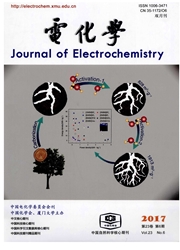

 中文摘要:
中文摘要:
本文利用激光诱导并结合控制一定的电极电位,在[BMIm]BF4/Pt电极体系中实现了激光诱导电沉积Cu基材料.研究表明在非沉积电位(-0.2 V)激光可诱导产生电沉积.激光的功率和照射时间对沉积产物有显著影响:功率越大,照射时间越长,则表面沉积物的量越多,且沉积仅仅发生在激光照射点以内.此类激光诱导电沉积的发生主要源于激光的热效应可使电极表面局域温度显著上升,从而降低沉积的阈值电位,促使电沉积在非沉积电位区间发生.SEM研究表明电极表面的沉积点由50 nm左右的纳米粒子聚集而成,进一步的EDS和拉曼光谱证明该产物主要由Cu和Cu2O的混合物组成.以对巯基苯甲酸(MBA)为探针分子,通过SERS信号的强度变化,现场监测了激光诱导电沉积的过程,在起始阶段其沉积物的SERS效应明显,随沉积时间延长,因沉积物增多其形貌发生变化,"热点"消失,其SERS效应反而降低并随后保持不变.同时,沉积点以外的SERS中并未检测到MBA,说明激光诱导作用仅仅发生在激光照射区域内,这为电极表面的定向沉积提供了新的途径.
 英文摘要:
英文摘要:
By controlling the negative potential, Cu-based materials were deposited at the [BMIm]BF4/Pt electrode interface under the laser irradiation. The effects of laser power and irradiation time on the yield of deposition products were studied by using different laser powers and different irradiation time. The product yield could be directly determined by the size of deposition point through the observation from the optical microscope. Further mechanism study combined with the formula deduced that the thermal effect of the laser could make the electrode surface temperature rise 110 degrees, which can promote the occurrence of electrodeposition. By SEM characterization, the deposition point was formed from nanoparticle aggregation with the diameter of 50 nm. The EDS and Raman spectra showed that the product was a mixture of Cu and Cu2O. The sedimentary formation and growth process could be monitored by the changes in the intensity of the SERS signals from 1 mmol·L^-1 of mercaptobenzoic acid(MBA). In addition, it was concluded based on the SERS experiments that no deposition products were formed without the laser irradiation.
 同期刊论文项目
同期刊论文项目
 同项目期刊论文
同项目期刊论文
 Inhibiting plasmon catalyzed conversion of para-nitrothiophenol on monolayer film of Au nanoparticle
Inhibiting plasmon catalyzed conversion of para-nitrothiophenol on monolayer film of Au nanoparticle The surface adsorption of 2,2’-bipyridine and benzoin on Cu electrode interface probed by surface-en
The surface adsorption of 2,2’-bipyridine and benzoin on Cu electrode interface probed by surface-en Plasmon-induced decarboxylation of mercaptobenzoic acid on nanoparticle film monitored by surface-en
Plasmon-induced decarboxylation of mercaptobenzoic acid on nanoparticle film monitored by surface-en Probing double layer structure at Au/[BMIm]BF4 interface by molecular length-dependent SERS Stark ef
Probing double layer structure at Au/[BMIm]BF4 interface by molecular length-dependent SERS Stark ef Improving the SERS detection sensitivity of aromaticmolecules by a PDMS-coated Au nanoparticle monol
Improving the SERS detection sensitivity of aromaticmolecules by a PDMS-coated Au nanoparticle monol Rapid separation and on-line detection by coupling high performance liquid chromatography with surfa
Rapid separation and on-line detection by coupling high performance liquid chromatography with surfa Electrochemical reduction of SPR-catalysate 4,4′-dimercaptoazobenzene at [BMIm]BF4/Ag interface prob
Electrochemical reduction of SPR-catalysate 4,4′-dimercaptoazobenzene at [BMIm]BF4/Ag interface prob 期刊信息
期刊信息
